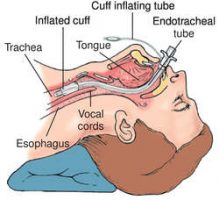- Home
- Editorial
- News
- Practice Guidelines
- Anesthesiology Guidelines
- Cancer Guidelines
- Cardiac Sciences Guidelines
- Critical Care Guidelines
- Dentistry Guidelines
- Dermatology Guidelines
- Diabetes and Endo Guidelines
- Diagnostics Guidelines
- ENT Guidelines
- Featured Practice Guidelines
- Gastroenterology Guidelines
- Geriatrics Guidelines
- Medicine Guidelines
- Nephrology Guidelines
- Neurosciences Guidelines
- Obs and Gynae Guidelines
- Ophthalmology Guidelines
- Orthopaedics Guidelines
- Paediatrics Guidelines
- Psychiatry Guidelines
- Pulmonology Guidelines
- Radiology Guidelines
- Surgery Guidelines
- Urology Guidelines
Endotracheal Intubation with Ultrasonography effective, faster: Indian Journal of Critical Care Medicine Study

Over the past few years, ultrasonography is increasingly being used to confirm the correct placement of endotracheal tube (ETT). In a recent study that was published in the Indian Journal of Critical Care Medicine, authors Vimal Koshy Thomas, Cherish Paul, Punchalil Chathappan Rajeev, Babu Urumese Palatty of Jubilee Mission Medical College and Research Institute, Kerala aimed to compare it with the traditional clinical methods and the gold standard quantitative waveform capnography. Two primary outcomes were measured in our study. First was the sensitivity and specificity of ultrasonography against the other two methods to confirm endotracheal intubation. The second primary outcome assessed was the time taken for each method to confirm tube placement in an emergency setting.
The authors performed a single-centered, prospective cohort study conducted in an emergency department of a tertiary care hospital. The study included 100 patients with indication of emergency intubation by convenient sampling. The intubation was performed as per standard hospital protocol. As part of the study protocol, ultrasonography was used to identify ETT placement simultaneously with the intubation procedure along with quantitative waveform capnography (end-tidal carbon dioxide) and clinical methods. Confirmation of tube placement and time taken for the same were noted by three separate health-care staffs.
The authors found that out of the 100 intubation attempts, five (5%) had esophageal intubations. The sensitivity and specificity of diagnosis using ultrasonography were 97.89% and 100%, respectively. This was statistically comparable with the other two modalities. The time taken to confirm tube placement with ultrasonography was 8.27 ± 1.54 s compared to waveform capnography and clinical methods which were 18.06 ± 2.58 and 20.72 ± 3.21 s, respectively. The time taken by ultrasonography was significantly less.
The authors concluded that Ultrasonography confirmed tube placement with comparable sensitivity and specificity to quantitative waveform capnography and clinical methods. But then, it yielded results considerably faster than the other two modalities.
The Study has been published in May 2017 issue of Indian Journal of Critical Care Medicine, the official journal of Indian Society of Critical Care Medicine
To read the article click on the given link below.
Thomas VK, Paul C, Rajeev PC, Palatty BU. Reliability of ultrasonography in confirming endotracheal tube placement in an emergency setting. Indian J Crit Care Med [serial online] 2017 [cited 2017 Jun 8];21:257-61. Available from: http://www.ijccm.org/text.asp?2017/21/5/257/206283

Disclaimer: This site is primarily intended for healthcare professionals. Any content/information on this website does not replace the advice of medical and/or health professionals and should not be construed as medical/diagnostic advice/endorsement or prescription. Use of this site is subject to our terms of use, privacy policy, advertisement policy. © 2020 Minerva Medical Treatment Pvt Ltd